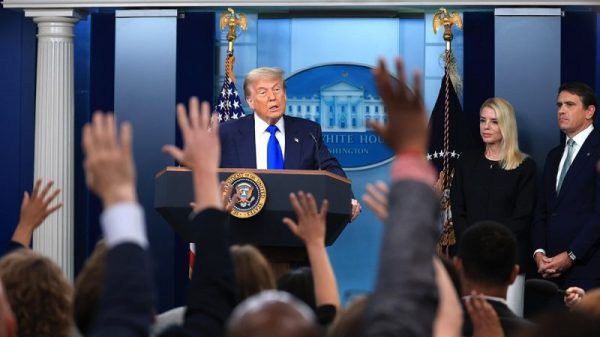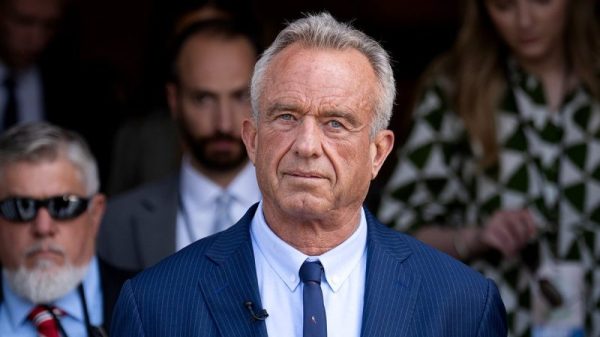Conservative Supreme Court justices expressed skepticism Wednesday that federal law can require hospitals to provide emergency abortion care in states with strict bans on the procedure, marking the latest legal battle over abortion access since the high court overturned Roe v. Wade nearly two years ago.
The sharply divided court appeared to split largely along ideological lines with only the three liberals strongly backing the Biden administration’s view that a 40-year-old emergency-care law conflicts with a strict state ban in Idaho, which imposes penalties of up to five years in prison on doctors who perform the procedure.
At issue is the Emergency Medical Treatment and Labor Act, which requires hospitals receiving federal funds to provide urgent care for all patients, regardless of their ability to pay. The Biden administration invoked the statute known as EMTALA after the Supreme Court eliminated the nationwide right to abortion in 2022.
The effort was seen as one of the few ways the administration could try to preserve emergency access to abortion, which remains a galvanizing and divisive issue in the lead-up to the 2024 presidential election. More than half of voters have said they believe this year’s national and state races will have a “major impact” on abortion access, with respondents more likely to trust Democrats rather than Republicans to handle the issue, according to polling conducted last month by KFF, a nonpartisan health research organization.
The justices will also decide this term whether to limit access to the widely used abortion medication mifepristone, approved more than 20 years ago by the Food and Drug Administration.
Throughout two hours of argument Wednesday, the liberal justices, who are all women, repeatedly highlighted the severe consequences that abortion bans have had on reproductive health in the United States. They pointed to harrowing examples of pregnant people facing health emergencies short of death, and the justices suggested those individuals would not be permitted to obtain an abortion under Idaho’s law. Justice Elena Kagan noted that pregnant people in need of emergency abortion care in Idaho were being transferred out of state for treatment.
“It’s become ‘transfer’ is the appropriate standard of care in Idaho, but it can’t be the right standard of care to force somebody onto a helicopter,” Kagan said.
Conservative justices, who make up the court majority, pushed back on the Biden administration’s interpretation of the statute and indicated that the federal government cannot force private hospitals that receive federal funds to violate a state law.
Justice Neil M. Gorsuch expressed concern about the scope of the federal government’s assertion and asked whether it could effectively transform “the regulation of medicine into a federal function” by attaching certain conditions to its funding of hospitals nationwide. Both Gorsuch and Justice Samuel A. Alito Jr. drew attention to the fact that the EMTALA statute does not mention abortion but includes the term “unborn child” when defining what constitutes a patient.
“Isn’t that an odd phrase to put in a statute that imposes a mandate to perform abortions? Have you ever seen an abortion statute that uses the phrase ‘unborn child?’” Alito asked Solicitor General Elizabeth B. Prelogar. “It seems the plain meaning is that the hospital must try to eliminate any immediate threat to the child.”
Prelogar said Congress added the language to expand protections for pregnant individuals to include treating conditions that specifically threaten the health and well-being of the unborn child — not to exclude protecting the pregnant person.
It was less clear based on their questions how three of the justices — Chief Justice John G. Roberts Jr. and Justices Brett M. Kavanaugh and Amy Coney Barrett, who are often in the middle on the bench with a 6-3 conservative majority — would resolve the case, which will be decided before the end of the term in late June or early July.
At one point, Barrett expressed frustration with Idaho’s attorney, suggesting he was “hedging” when he asserted that state law allows doctors to use their medical judgment and in “good faith” to determine whether a lifesaving abortion is permitted.
Barrett suggested the Idaho attorney’s answers to Justice Sonia Sotomayor’s hypotheticals, which were about whether state law would allow an abortion to address certain threatening conditions short of death, were at odds with representations in his written filings.
“I’m kind of shocked, actually, because I thought your own expert had said below that these kinds of cases were covered — and you’re now saying they’re not?” Barrett asked, referring to the examples of threats to a pregnant individual’s health.
Idaho’s lawyer, Joshua Turner, in response said the law allows doctors to exercise their medical judgment to determine if an abortion is necessary.
Turner later emphasized that state law “does not require that doctors wait until a patient is on the verge of death” to provide care.
But Barrett and Roberts pressed the state’s lawyer about whether prosecutors or other state officials could second-guess a doctor’s determination.
“What happens if a dispute arises with respect to whether or not the doctor was within the confines of Idaho law or wasn’t? Exactly how is that evaluated?” Roberts asked. Turner said that doctors are overseen by medical boards officials and that prosecutors have discretion when deciding to take action.
Idaho was one of several states to pass a “trigger” law before the Supreme Court’s 2022 decision in Dobbs v. Jackson Women’s Health Organization, with the expectation that it would automatically take effect if the high court overturned Roe. The Idaho law bans almost all abortions and imposes penalties of up to five years in prison on doctors who perform the procedure, with an exception of when “necessary to prevent the death of a pregnant woman.”
The administration sued Idaho in August 2022, saying that the state’s restrictions are preempted by the federal law and that strict state bans have confused health workers, confounded patients and led to delays in lifesaving care for pregnant people.
Prelogar emphasized the distinction between the state law that permits abortion only when a person is at risk of death and the care federal law requires when a pregnant individual has a serious medical condition.
“In Idaho, doctors have to shut their eyes to everything except death,” Prelogar said. “Whereas under EMTALA, you’re supposed to be thinking about things like, ‘Is she about to lose her fertility? Is her uterus going to become incredibly scarred because of the bleeding? Is she about to undergo the possibility of kidney failure?’”
Conservatives counter that the White House is stretching a law that makes no mention of the procedure so it can justify abortion access. The text of the statute requires hospitals to offer “any individual” with an emergency medical condition “such treatment as may be required to stabilize the medical condition.”
Turner, Idaho’s acting solicitor general, said the federal statute does not permit emergency room doctors to ignore state abortion restrictions. Just as individual states have different rules for dispensing opioids to manage pain, he said, doctors are required to abide by state medical regulations.
“Illegal treatments are not available treatments,” Turner said.
Since Roe was overturned, dozens of stories have emerged of people with high-risk pregnancy complications being turned away from hospitals in states with abortion bans. While all of the bans include some kind of medical exception for the life or health of the pregnant individual, the language is often vague, leaving doctors unsure of whether they can legally provide an abortion. In many states, the penalty for violating an abortion ban is at least several years in prison. Six other states have restrictions similar to those in Idaho’s law and do not include a health exception, Prelogar told the court Wednesday.
In 2022, officials at the Centers for Medicare and Medicaid Services issued guidance to hospitals receiving Medicare funds that emergency room doctors must terminate pregnancies in some circumstances, even if a state’s law bars the procedure. Hospitals that do not comply face penalties of up to $120,000 per violation.
Experts have warned that if the Supreme Court rules against the Biden administration, states could be empowered to pick and choose how to apply the federal emergency-care law well beyond abortion.
Lower courts have issued conflicting decisions. A district judge in August 2022 sided with the Biden administration and temporarily blocked the contested provision of the Idaho law. The judge left the state’s ban on most abortions in place but said that because of the obligation of hospitals under conflicting federal law, a doctor cannot be punished for performing an abortion to protect a patient’s health.
Then a three-judge panel of the U.S. Court of Appeals for the 9th Circuit allowed the state to enforce the law — before a full complement of judges on the same appeals court again blocked Idaho’s ability to punish emergency room doctors while the appeals continued.
In January, the Supreme Court agreed to take the case, Idaho v. United States, in response to Idaho’s emergency request and allowed the law to take effect while litigation continued.
In a separate case in Texas, the conservative U.S. Court of Appeals for the 5th Circuit ruled against the Biden administration, saying state hospitals and doctors are not obligated to perform abortions under the federal emergency-care law.
Kim Bellware, Dan Diamond and Perry Stein contributed to this report.
Conservative Supreme Court justices expressed skepticism Wednesday that federal law can require hospitals to provide emergency abortion care in states with strict bans on the procedure, marking the latest legal battle over abortion access since the high court overturned Roe v. Wade nearly two years ago.
The sharply divided court appeared to split largely along ideological lines with only the three liberals strongly backing the Biden administration’s view that a 40-year-old emergency-care law conflicts with a strict state ban in Idaho, which imposes penalties of up to five years in prison on doctors who perform the procedure.
At issue is the Emergency Medical Treatment and Labor Act, which requires hospitals receiving federal funds to provide urgent care for all patients, regardless of their ability to pay. The Biden administration invoked the statute known as EMTALA after the Supreme Court eliminated the nationwide right to abortion in 2022.
The effort was seen as one of the few ways the administration could try to preserve emergency access to abortion, which remains a galvanizing and divisive issue in the lead-up to the 2024 presidential election. More than half of voters have said they believe this year’s national and state races will have a “major impact” on abortion access, with respondents more likely to trust Democrats rather than Republicans to handle the issue, according to polling conducted last month by KFF, a nonpartisan health research organization.
The justices will also decide this term whether to limit access to the widely used abortion medication mifepristone, approved more than 20 years ago by the Food and Drug Administration.
Throughout two hours of argument Wednesday, the liberal justices, who are all women, repeatedly highlighted the severe consequences that abortion bans have had on reproductive health in the United States. They pointed to harrowing examples of pregnant people facing health emergencies short of death, and the justices suggested those individuals would not be permitted to obtain an abortion under Idaho’s law. Justice Elena Kagan noted that pregnant people in need of emergency abortion care in Idaho were being transferred out of state for treatment.
“It’s become ‘transfer’ is the appropriate standard of care in Idaho, but it can’t be the right standard of care to force somebody onto a helicopter,” Kagan said.
Conservative justices, who make up the court majority, pushed back on the Biden administration’s interpretation of the statute and indicated that the federal government cannot force private hospitals that receive federal funds to violate a state law.
Justice Neil M. Gorsuch expressed concern about the scope of the federal government’s assertion and asked whether it could effectively transform “the regulation of medicine into a federal function” by attaching certain conditions to its funding of hospitals nationwide. Both Gorsuch and Justice Samuel A. Alito Jr. drew attention to the fact that the EMTALA statute does not mention abortion but includes the term “unborn child” when defining what constitutes a patient.
“Isn’t that an odd phrase to put in a statute that imposes a mandate to perform abortions? Have you ever seen an abortion statute that uses the phrase ‘unborn child?’” Alito asked Solicitor General Elizabeth B. Prelogar. “It seems the plain meaning is that the hospital must try to eliminate any immediate threat to the child.”
Prelogar said Congress added the language to expand protections for pregnant individuals to include treating conditions that specifically threaten the health and well-being of the unborn child — not to exclude protecting the pregnant person.
It was less clear based on their questions how three of the justices — Chief Justice John G. Roberts Jr. and Justices Brett M. Kavanaugh and Amy Coney Barrett, who are often in the middle on the bench with a 6-3 conservative majority — would resolve the case, which will be decided before the end of the term in late June or early July.
At one point, Barrett expressed frustration with Idaho’s attorney, suggesting he was “hedging” when he asserted that state law allows doctors to use their medical judgment and in “good faith” to determine whether a lifesaving abortion is permitted.
Barrett suggested the Idaho attorney’s answers to Justice Sonia Sotomayor’s hypotheticals, which were about whether state law would allow an abortion to address certain threatening conditions short of death, were at odds with representations in his written filings.
“I’m kind of shocked, actually, because I thought your own expert had said below that these kinds of cases were covered — and you’re now saying they’re not?” Barrett asked, referring to the examples of threats to a pregnant individual’s health.
Idaho’s lawyer, Joshua Turner, in response said the law allows doctors to exercise their medical judgment to determine if an abortion is necessary.
Turner later emphasized that state law “does not require that doctors wait until a patient is on the verge of death” to provide care.
But Barrett and Roberts pressed the state’s lawyer about whether prosecutors or other state officials could second-guess a doctor’s determination.
“What happens if a dispute arises with respect to whether or not the doctor was within the confines of Idaho law or wasn’t? Exactly how is that evaluated?” Roberts asked. Turner said that doctors are overseen by medical boards officials and that prosecutors have discretion when deciding to take action.
Idaho was one of several states to pass a “trigger” law before the Supreme Court’s 2022 decision in Dobbs v. Jackson Women’s Health Organization, with the expectation that it would automatically take effect if the high court overturned Roe. The Idaho law bans almost all abortions and imposes penalties of up to five years in prison on doctors who perform the procedure, with an exception of when “necessary to prevent the death of a pregnant woman.”
The administration sued Idaho in August 2022, saying that the state’s restrictions are preempted by the federal law and that strict state bans have confused health workers, confounded patients and led to delays in lifesaving care for pregnant people.
Prelogar emphasized the distinction between the state law that permits abortion only when a person is at risk of death and the care federal law requires when a pregnant individual has a serious medical condition.
“In Idaho, doctors have to shut their eyes to everything except death,” Prelogar said. “Whereas under EMTALA, you’re supposed to be thinking about things like, ‘Is she about to lose her fertility? Is her uterus going to become incredibly scarred because of the bleeding? Is she about to undergo the possibility of kidney failure?’”
Conservatives counter that the White House is stretching a law that makes no mention of the procedure so it can justify abortion access. The text of the statute requires hospitals to offer “any individual” with an emergency medical condition “such treatment as may be required to stabilize the medical condition.”
Turner, Idaho’s acting solicitor general, said the federal statute does not permit emergency room doctors to ignore state abortion restrictions. Just as individual states have different rules for dispensing opioids to manage pain, he said, doctors are required to abide by state medical regulations.
“Illegal treatments are not available treatments,” Turner said.
Since Roe was overturned, dozens of stories have emerged of people with high-risk pregnancy complications being turned away from hospitals in states with abortion bans. While all of the bans include some kind of medical exception for the life or health of the pregnant individual, the language is often vague, leaving doctors unsure of whether they can legally provide an abortion. In many states, the penalty for violating an abortion ban is at least several years in prison. Six other states have restrictions similar to those in Idaho’s law and do not include a health exception, Prelogar told the court Wednesday.
In 2022, officials at the Centers for Medicare and Medicaid Services issued guidance to hospitals receiving Medicare funds that emergency room doctors must terminate pregnancies in some circumstances, even if a state’s law bars the procedure. Hospitals that do not comply face penalties of up to $120,000 per violation.
Experts have warned that if the Supreme Court rules against the Biden administration, states could be empowered to pick and choose how to apply the federal emergency-care law well beyond abortion.
Lower courts have issued conflicting decisions. A district judge in August 2022 sided with the Biden administration and temporarily blocked the contested provision of the Idaho law. The judge left the state’s ban on most abortions in place but said that because of the obligation of hospitals under conflicting federal law, a doctor cannot be punished for performing an abortion to protect a patient’s health.
Then a three-judge panel of the U.S. Court of Appeals for the 9th Circuit allowed the state to enforce the law — before a full complement of judges on the same appeals court again blocked Idaho’s ability to punish emergency room doctors while the appeals continued.
In January, the Supreme Court agreed to take the case, Idaho v. United States, in response to Idaho’s emergency request and allowed the law to take effect while litigation continued.
In a separate case in Texas, the conservative U.S. Court of Appeals for the 5th Circuit ruled against the Biden administration, saying state hospitals and doctors are not obligated to perform abortions under the federal emergency-care law.
Kim Bellware, Dan Diamond and Perry Stein contributed to this report.





















